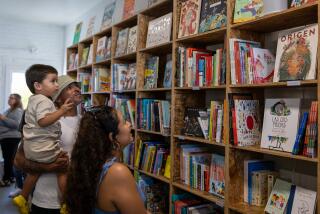Checkouts From This Library Squeak, Hiss and Nibble
- Share via
IMPERIAL BEACH — Brian Bennett loves reptiles.
He loves them so much that his pets include two garter snakes, a water snake and three lizards. When he wants information about the slithery creatures, 11-year-old Brian goes to the library at Oneonta Elementary School. But he does not get a book.
Brian presents the librarian a note from his parents and gets Valentino, a black Canadian garter snake with yellow and orange stripes swirling down its body. He puts “Valentino” in a cigar box covered with American flag stickers and takes him home. From that moment on, Brian is in a state of bliss. Some might even call it snake heaven.
“They’re exciting to watch and they’re neat,” Brian said, as a swarm of students gathered around him for a peek inside the cigar box. “My brother wants to get a boa constrictor, but my mom and dad won’t let him.”
If students want to learn about rabbits, hamsters or guinea pigs, they can check them out, too, at the Oneonta pet library, one of the few of its kind in the country.
Its 11 cuddly holdings, however, make the library a popular place for many South Bay youths. Among the selections are Baby D, the fuzz ball hamster; the generic bunny couple, Mr. and Mrs. Clone, and Puff the magic Angora bunny. Puff is soft as a ball of Carolina cotton, but resembles an owl with long ears.
The pets are loaned on a first-come, first-served basis and parental permission is a must before any animal goes home. Students may check out animals during the week and over weekends.
The animals not only serve as a friend for children who might normally go home to an empty house. They also teach them responsibility.
“The overall thing is for the kids to relate to the non-threatening environment the animals provide,” said Al Walters, a sixth-grade teacher and head librarian who organized the program.
“I found that animals were a good way to teach,” he said. “I saw that there was a need for kids who didn’t know how to handle animals. They need that experience of caring for something. The reason we have that cross section of animals is that there’s something that appeals to everyone.”
The most popular pets in the library are the hamsters and guinea pigs, Walters said. Students can simply put them in their pockets or in a small red cage that looks like a miniature lunch box. The rabbits travel in wire cages complete with dining and drinking trays and an overnight supply of munchies. The library even provides a little red wagon for students to carry the larger cages.
Walters said animals have always been part of his life. He discovered how they could be used as a teaching tool when he helped set up a one-room school in 1980 for an American company in Choluteca, Honduras.
There, students studied fish and the ocean environment by snorkeling in nearby waters, Walters said. He also brought jungle animals to school for the class to observe. Some of them, such as an eight-pound iguana, were a bit more exotic than rabbits and hamsters, he said.
When he returned to California in 1982, Walters thought the pet library could be used as a teaching tool here, too.
When he opened the library later that year, Walters had only a snake and a rabbit. But parents and their children soon donated animals and “as the demand grew, the (number of) animals grew,” he said. “It got a little more popular than we thought it would.”
The library operates from Walters’ classroom, No. 15. Inside, a crew of sixth-graders feed the animals, clean the cages and keep a list of the animals on loan.
Other teachers are equally enthusiastic about the pet library and say they use the animals to motivate their students.
Walters’ wife, Janella, shares his belief that the pets provide a unique pedagogical tool. Janella, who teaches handicapped children at Oneonta, said Puff spends most of his school days in her class. She said the children take turns cleaning his cage each day for an opportunity to hold the little furry animal during show and tell sessions.
“They’re all fighting to clean up after him,” Janella said. “They would complete all their work to hold the bunny at recess. When the children are holding Puff, they’re just in heaven.”
Michiko, a black and white lop-eared rabbit with a fetish for Oreo cookies, lives in Gerry Hill’s classroom. Her students weren’t too excited about cleaning up after the rabbit when he arrived, Hill said. But after Michiko had been there for about a week, the students decided that taking care of him was fun.
The only chance that some of the children have to care for animals is at school, Hill said. The responsibility they learn now, she said, will help them later in life.
“It makes them feel important,” she said. “When a student is given the responsibility (to care for an animal), all of a sudden something needs them. There is something in the room that needs their help.”
“The kids are just fascinated by the animals,” said Oneonta Principal Johanna Vetcher. “They give up their recess to groom and feed the animals. I think it’s worked out well for building responsibility, trust and and a bit of leadership among the kids.”
The animals travel about every two days, so they must be ready to hit the road at any time. Walters and his sixth-graders watch the animals’ behavior and if any of them look tired, they send them on vacation to a teacher’s home.
The library keeps pairs of animals in the hope that they will have litters in the spring. After the baby animals grow, they are given away as good citizenship awards to students who have shown good will toward their fellow man and animal, Walters said. About 40 pets raised by the students have been given away since the library opened.
Although Walters says the overall experience of the animal loan program has been positive, there have been a few problems.
When Rose Liddic, 11, checked out a hamster over Thanksgiving, it escaped from the cage and her entire family spent the holiday looking for it. “It got out and we had to clean the house to find it,” Rose said.
The children generally take good care of the animals, Walters said, but, “We lost a snake last year when someone kept it warm on top of their furnace.”
One little girl became so attached to a hamster that Walters said he had to ask her repeatedly to bring it back. She finally did return it, albeit begrudgingly.
Still, the story had a happy ending: Her parents bought her a hamster of her own.






